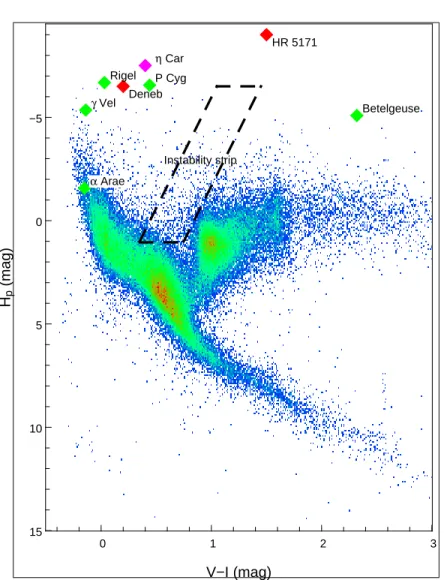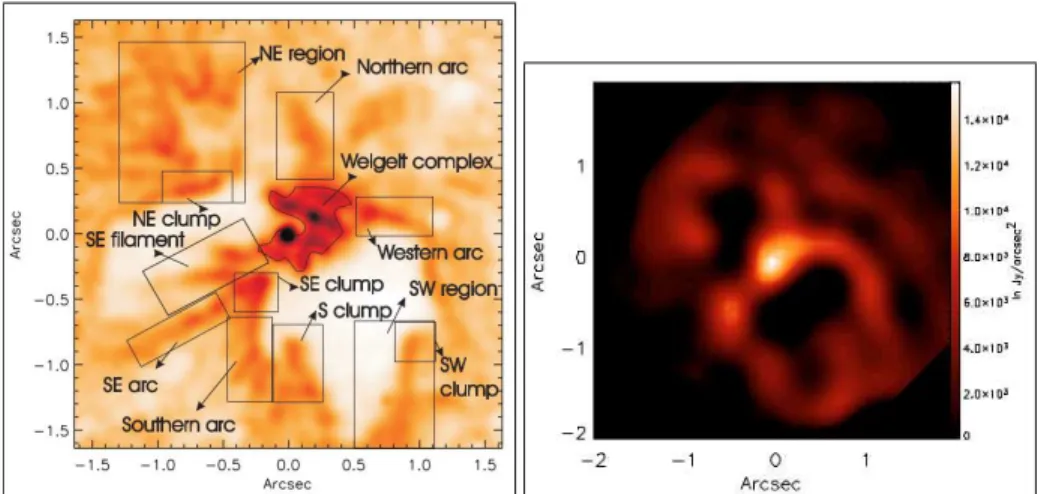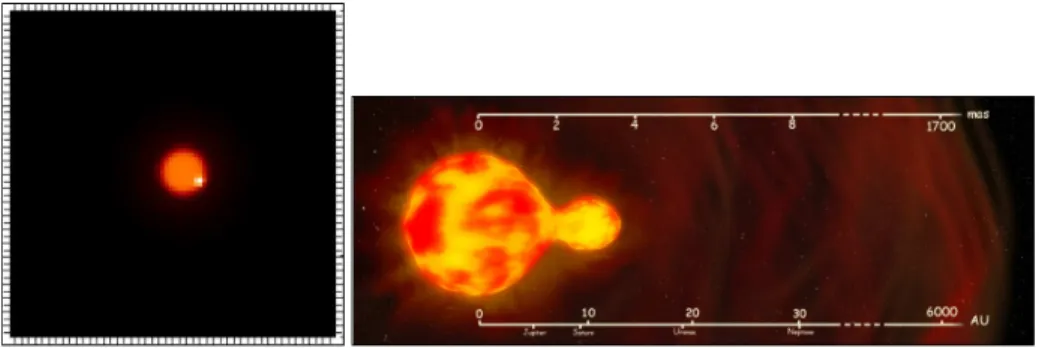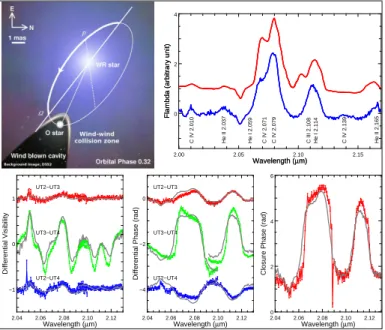HAL Id: hal-01238158
https://hal.archives-ouvertes.fr/hal-01238158
Submitted on 3 Mar 2016
HAL is a multi-disciplinary open access
archive for the deposit and dissemination of
sci-entific research documents, whether they are
pub-lished or not. The documents may come from
teaching and research institutions in France or
abroad, or from public or private research centers.
L’archive ouverte pluridisciplinaire HAL, est
destinée au dépôt et à la diffusion de documents
scientifiques de niveau recherche, publiés ou non,
émanant des établissements d’enseignement et de
recherche français ou étrangers, des laboratoires
publics ou privés.
Olivier Chesneau’s work on massive stars
Florentin Millour
To cite this version:
Florentin Millour. Olivier Chesneau’s work on massive stars. The Physics of Evolved Stars, F. Millour;
E. Lagadec; T. Lanz, Jun 2015, Nice, France. �10.1051/eas/1571003�. �hal-01238158�
OLIVIER CHESNEAU’S WORK ON MASSIVE STARS
F. Millour
1Abstract. Olivier Chesneau challenged several fields of observational stellar astrophysics with bright ideas and an impressive amount of work to make them real in the span of his career, from his first paper on P Cygni in 2000, up to his last one on V838 Mon in 2014. He was using all the so-called high-angular resolution techniques since it helped his science to be made, namely study in details the inner structure of the environments around stars, be it small mass (AGBs), more massive (supergiant stars), or explosives (Novae). I will focus here on his work on massive stars.
1
Introduction
The first published paper of Olivier Chesneau was on P Cygni (Chesneau et al. 2000), the prototype Luminous Blue Variable star (LBV), observed with one of the first astronomical adaptive optics system, the Banc d’Optique Adaptative at the Observatoire de Haute Provence 1.52 m telescope. He could resolve the emission-line shell around this star and infer its mass loss. He later started his PhD thesis on Wolf-Rayet stars because “Wolf-Rayet” sounded nice to his ears. He was a very nice person with a never-ending curiosity, and his enthusiasm in peering into the physics of stars marked all his collaborators.
2
Why are massive stars interesting?
We know today that some massive stars do explode as supernovae. As such, they contribute to the kinematic feedback, compressing and concentrating the interstellar medium (ISM) in some parts of the Galaxy, and posing the initial conditions for future generations of stars. Are all the massive stars progenitors of some supernovae? This is being investigated nowadays and was one of the questions O. Chesneau wanted to tackle in the future.
1Laboratoire Lagrange, UMR7293, Universit´e Cˆote d’Azur, Observatoire de la Cˆote d’Azur,
CNRS, Bd. de l’Observatoire, 06300 Nice, France e-mail: fmillour@oca.eu
Document prepared by the author DOI: 10.1051/eas/1571003
2 What can the highest angular resolution bring to stellar astrophysics?
Massive stars form a very heterogeneous zoo, that astronomers have arbitrar-ily classified as a function of temperature and luminosity. They range from the low-temperature and high-luminosity red supergiant stars (RSG), through yellow supergiant (YSG) and hypergiant (YHG) stars, up to the high-temperature OB stars, be it on the main sequence or more peculiar Wolf-Rayet stars (WR), Lu-minous Blue Variable stars (LBV) or B[e] supergiant stars. Figure 1 shows the massive stars that O. Chesneau focused on. They range from the cool supergiant star Betelgeuse up to the hot Wolf-Rayet star Gamma Vel, all of them far up in the Hertzsprung-Russel (HR) diagram.
Even during their short life (a few million years), these fat stars have a tremen-dous mass loss, influencing their local environment and sometimes triggering star formation in their vicinity. Detecting the signatures of mass loss in massive stars formed the main scientific playground of O. Chesneau. It can manifest itself in the form of a stellar wind and/or dust clumps that form in the nearest vicinity of the star.
These stars also have very high luminosity in the range 105
−107L⊙ which
are the first source of ionization in our Galaxy, revealing the interstellar clouds in fine and colorful laces in star-forming regions. The high luminosity of massive stars helps in forming dense and strong winds, but it may sound like an apparent burden to form dust, which would be prevented from condensing by the intense ultraviolet radiation of the central star. Aspherical environments can help provide an explanation to dust formation in the vicinity of such monsters. O. Chesneau was fond of disks (as they are relatively easy to detect with interferometry), and he was always happy when he was discovering one around a star, but massive stars have heavily challenged his – and ours – conceptions on their close-by environments as asymmetries happen to be basically everywhere.
I will present here only three prominent of O. Chesneau’s papers, on which I had the chance to interact with him, be it a long time after he published it (Eta Car) or for which I actually worked with him.
3
Picturing the behemoth
One of these challenging stars is Eta Carinae.
I did not work with O. Chesneau on this system, but I could get his own impressions on it after the paper was published. He started studying it through his implication in building the Mid-Infrared (MIDI) instrument of the Very Large Telescope Interferometer (VLTI), and he was trying to extract relevant information from the observations he made. The multi-instrument observing campaign he carried out on the system revealed a very complex inner structure, where the dust form. The interpretation of these structures happened to be very difficult for him. He finally could resolve the dust-sublimation region around the central star and described the complex morphology of the dust in its vicinity, showing for the first time the so-called “butterfly” nebula, a dust-empty region in the core of the larger scale Homunculus nebula (see Fig. 2).
HR 5171 Deneb P Cyg Betelgeuse α Arae γ Vel η Car Rigel Instability strip 0 1 2 3 −5 0 5 10 15 V−I (mag) Hp (mag)
Fig. 1. A Hertzsprung-Russel diagram generated from the Hipparcos catalog (Perryman et al. 1997), in order to make it look like the one published on the ESA web-pages, showing the diagonal main-sequence of stars, and the upper-right branch of cool giant stars. The massive stars which were observed and published by O. Chesneau are marked with Hipparcos-only colors and magnitudes (green), or with values from the literature (red and magenta). The instability strip, where the stars are pulsating or supposedly extremely short-lived, is marked in dashed line.
O. Chesneau was later saying to the students in the laboratory, like me, that he was directing his day-to-day research based on the lessons learned from his work on Eta Car. Indeed, he was not well-prepared at that time to make a complete study of the system. He could only be descriptive in his article, but could not go
4 What can the highest angular resolution bring to stellar astrophysics?
Fig. 2.The “Butterfly” nebula within the Eta Car nebula from Chesneau et al. (2005b). Left: In the near-infrared (with annotations). Right: In mid-infrared.
further in the interpretation due to the complexity of the object. Therefore, he focused later to “simpler” objects like binaries and disks, for which he had built very efficient observing methods and interpretation tools. For every new study, when difficulties arouse in the interpretation of the data, he was always saying in substance that “this or that star is too complicated for me”, but he always was digging the subject to the very bottom and he was always finding striking new properties on the stars he touched by means of his favourite tools, i.e. adaptive optics with the Very Large Telescope (VLT), and long-baseline interferometry with the VLTI array and the CHARA array.
4
An unexpected binary monster
O. Chesneau was fond of all the objects with a high luminosity and a high mass (but he was also fond of low-mass objects, see the previous paper (Lagadec 2015). Following his works on LBVs, he got interested on the difference between LBVs and another type of high-luminosity objects, namely yellow hypergiant stars. These stars were thought to be some kind of more unstable (if it could be) LBV stars, which are evolving very fast with time, skyrocketing to the left (getting hotter) or to the right (getting cooler) in the HR diagram.
O. Chesneau looked into these extremely rare stars (about 10 are known in our Galaxy) and found out that they were basically unstudied, except from a few spec-tra and photometric data obtained a long time ago on some of them. He therefore decided to get simple information on them such as a diameter measurement, in order to clear the path of future investigations. He made a telescope time proposal with the help of S. Kanaan from Valparaiso to effectively measure the diameter of two YHG stars V382 Car and HR5171a.
The proposal was accepted and carried out by the VLTI. When looking at the Astronomical Multi-Beam Recombiner (AMBER/VLTI) data, O. Chesneau could get a first interpretation on V382 Car, but the HR5171a data resisted all attempts to use standard interpretation tools. This is when he came to me with the data set he had, telling me in substance “I tried many tools and ideas on this star but could not get a reliable diameter. I know you might have some tools which can be of help, could you please take a look to it?”, a challenge which I immediately accepted. When taking a look at the data on the star, I noticed that it was not a plain single star, but probably made of an unexpectedly large main star, in addition to an off-center bright “blob” or a companion star (see Fig. 3). I remember the excitement of O. Chesneau to this unsuspected new fact and he immediately set up a strategy to prove it was indeed a companion star, by sending a message to his collaborators starting by the nice sentence: “Florentin [...] ’sees’ binaries everywhere... And he might be right!!!”.
Fig. 3. Left: One of the first pictures made on HR5171a and circulated among co-authors. Right: The final picture of the system based on the Roche-lobe overflow model of A. Meilland, as published (Chesneau et al. 2014a).
One peculiarity of this new found companion was the proximity to the main star, nearly in contact with the main star photosphere. O. Chesneau therefore contacted photometric specialists to check if there was a periodic variability, and indeed there was one! This clarified substantially the picture of the system, which happened to be formed of an extremely large star and a contact companion star, in a so-called extremely rare common-envelope phase, where the companion star is basically spiralling within the external layers of the main star (Chesneau et al. 2014a). This kind of object can evolve rapidly up until a merger event, like e.g. the V838 Mon event (Chesneau et al. 2014b).
This is it on HR5171, because as O. Chesneau wrote in an email to all the co-authors in one of his typical enthusiastic messages, “Explaining all the develop-ments of the HR 5171 A project would be a (too) long (and wonderful!) story to tell.”
6 What can the highest angular resolution bring to stellar astrophysics?
5
Setting the distance to Gamma Vel
I need to say a word on Gamma Vel before concluding this paper.
Gamma Vel is the closest WR+O star to Earth. As such, not only the binary system but also the WR wind and shocked region between the WR & O winds could potentially be resolved by the VLTI. O. Chesneau set-up an observing program within the AMBER consortium to observe this system, which was his “pet” star. As early as the end of the first AMBER scientific night of observation, in December 2004 (when Gamma Vel was first observed), O. Chesneau sent a warming congratulations message addressed to the whole observing team: “Great!!!!!!!!!!!!! Congratulation to all of you, I know how these observations can be stressful and exhausting. I wish to the observer and the AMBER team other sucessfull nights and a rich scientific harvest for AMBER. Good luck for the end of the run, Olivier”.
From the beginning, we were sure we had a wealth of information in the Gamma Vel AMBER data, but we were puzzled by the interpretation complexity of the spectro-interferometric measurements. Since spectroscopy and interferometry were mixed for the first time in the near infrared, we had to clear the path of interpreting such datasets.
When I moved to Nice in 2005, I started the real hard work on that object (and others) with the wonderful enlightening of Olivier’s prolific ideas and help (with many visits to the then-separate laboratories).
He was always coming up with bright ways of overcoming apparently invulner-able boundaries in our work. I remember spending hours in front of a whiteboard drawing sketches and writing equations together to solve the interpretation prob-lem we had on Gamma Vel data. The pragmatism of Olivier finally took over and we ended up making a simple geometrical model of the system, together with a thorough investigation of other sources of information on the object, which hap-pened to learn us many things on the system: the distance we were measuring on that target was at odds with the Hipparcos one, and we could constrain the physical parameters of the WR wind.
The AMBER paper of Gamma Vel (Millour et al. 2007) (see Fig. 4) was an excellent training on how to perform research for the young student I was. O. Ches-neau’s enthusiasm and hard work were communicative and stimulating. I can write that the exchanges with O. Chesneau, starting from these ones on the Gamma Vel work, were decisive in my life, as they convinced me that the field of astrophysics and instrumentation research were what I wished to do later.
6
Concluding note: the impact of O. Chesneau work on stellar physics.
To illustrate the workforce of Olivier Chesneau, I will make here a necessarily inaccurate and incomplete summary of his work. To give numbers, he wrote or contributed to 97 peer-review articles, i.e. he was contributing to the impressive number of 7 papers per year in average (less than that at the beginning, closer to 10 papers per year later). This represents about one out of four papers that were
UT2−UT3 UT3−UT4 UT2−UT4 2.04 2.06 2.08 2.10 2.12 −4 −2 0 Wavelength (µm)
Differential Phase (rad)
2.04 2.06 2.08 2.10 2.12 0 2 4 6 Wavelength (µm)
Closure Phase (rad)
UT2−UT3 UT3−UT4 UT2−UT4 2.04 2.06 2.08 2.10 2.12 −1 0 1 Wavelength (µm) Differential Visibility C IV 2.010 He II 2.037 He I 2.059 C IV 2.071 C IV 2.079 C III 2.108 He I 2.114 C IV 2.139 He II 2.165 2.00 2.05 2.10 2.15 0 2 4 Wavelength (µm)
Flambda (arbitrary unit)
Wavelength (µm)
Flambda (arbitrary unit)
Fig. 4.A summary of Gamma Vel observations (first published in the MPIfR Fachbeirat report in 2007). Top-Left: Illustration of the system with the WR and O stars plus the wind-wind collision zone. Top-Right: The observed spectrum (left) compared to the best-fit model (red). Bottom, from left to right: Differential visibilities, differential phases and closure phases on Gamma Vel (Millour et al. 2007).
written with VLTI data. At the date of today (2015), each of his articles received about 25 citations in average.
Apart from rough numbers, he was heavily involved in the MIDI data analysis software development, and as such he contributed to the two highest impact papers of all history of interferometry, namely the resolution of the dusty torus of an active galaxy nucleus (Jaffe et al. 2004), and the discovery of radial segregation of dust in protoplanetary disks (van Boekel et al. 2004).
On the hot stars side, his most prominent papers are on the behemoth Eta Cari-nae (Chesneau et al. 2005b) and the fast rotator α Arae (Chesneau et al. 2005a), both setting a change in the vision of these particular class of objects.
He was involved in national an international bodies to make better science with the current facilities, among others ASHRA, EII, and JMMC, and was also active in new projects like SPHERE and MATISSE.
Many people will remember O. Chesneau as a kind person, full of enthusiasm. He touched many young researchers that will pursue his work in the future.
The author would like to thank E. Lagadec, A. Meilland and L. Rolland for reading through this paper and making suggestions for improvements.
8 What can the highest angular resolution bring to stellar astrophysics?
References
Chesneau, O., Meilland, A., Chapellier, E., et al. 2014a, A&A, 563, A71 Chesneau, O., Meilland, A., Rivinius, T., et al. 2005a, A&A, 435, 275 Chesneau, O., Millour, F., De Marco, O., et al. 2014b, A&A, 569, L4 Chesneau, O., Min, M., Herbst, T., et al. 2005b, A&A, 435, 1043 Chesneau, O., Roche, M., Boccaletti, A., et al. 2000, A&AS, 144, 523 Jaffe, W., Meisenheimer, K., R¨ottgering, H. J. A., et al. 2004, Nature, 429, 47 Lagadec, E. 2015, in this book
Millour, F., Petrov, R. G., Chesneau, O., et al. 2007, A&A, 464, 107
Perryman, M. A. C., Lindegren, L., Kovalevsky, J., et al. 1997, A&A, 323, L49 van Boekel, R., Min, M., Leinert, C., et al. 2004, Nature, 432, 479



